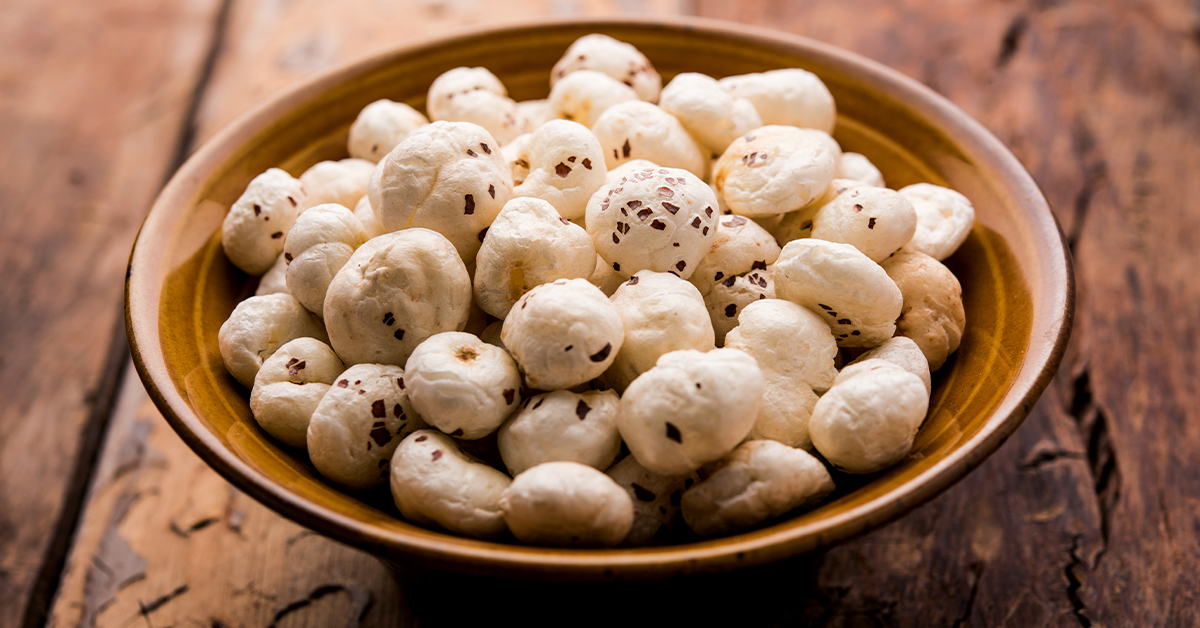All About Makhana - What is Makhana (Fox Nuts) and Where Does it Come From?
Makhana is also called “fox nuts”. Unlike the other unhealthy snacks available in the market, there are crunchy and healthy. Therefore this makes them a perfect option for a healthy snack. Read on to know more about the history, uses, and some delicious recipes of makhana.
What Is Makhana?
Makhana or “Fox nuts” are the seeds of the lotus plant. These seeds are edible and healthy. In fact, there are plenty of Health Benefits of Makhana. These delectable snacks are rich in vitamins & minerals, iron, calcium, etc.
History Of Makhana
A bowl full of makhana topped with black pepper makes a fantastic substitute for popcorns! But did you know about their rich history? Historically, Bihar is known as the birthplace of makhana. Let’s know more about the exciting history of this crunchy snack!
Bihar - The Birthplace Of Makhana
In the 18th century, under the orders of the king of Darbhanga makhana cultivation began. Did you know that during those times the farmers used to get Rs 3 per acres as a profit for makhana cultivation?
Gullobara bazaar is located in the Darbhanga district of Bihar. It is one of the major trading centers in India. On an estimate around 2000 metric tonnes of makhana is traded annually from this district alone!
After this, the makhana cultivation reached china, Malaysia, Pakistan, Bangladesh, etc.
Cultural Impact Of Makhana
In the regions of Koshi Mithila, makhana is an integral part of marriage ceremonies. The garlands and dishes made from makhana have an important role in the ceremonies.
In Hindu communities, makhana is used as a religious food for breaking the fast during the holy festival of Navaratri. Makhana kheer is a very famous delicacy in north India.
Furthermore, even in Muslim communities, makhana is used to break the Roza fast during the holy month of Ramzan.
What Makes Makhana Unique?
You might be wondering, what’s so special about makhana. Don’t worry! We’ve got your back! Let’s understand what’s exactly so unique about these crunchy seeds?
They have high ascorbic acid and antioxidants content than other dry fruits like walnuts, cashews, etc.
They have a very low glycemic index! Which means they won’t raise your blood sugar after eating them. Therefore, they are excellent for diabetic people.
It’s high in carbohydrates & low in fats.
Rich in micro-nutrients like - zinc, magnesium, potassium, and phosphorus.
Also contains kaempferol and disease-fighting nutrients like onphyto-nutrients (alkaloids, gallic acid, saponins.)
How Is Makhana Harvested?
Did you know that makhana cultivation contributes to about 40% of the cultivation in Bihar? Now, that’s amazing! Let’s understand how exactly these crunchy delights are cultivated.
The white-colored seeds are harvested when the seed head is immature. Then, the unpleasant bitter-tasting germ layer is removed by the hand.
The brown-colored seeds are harvested when the seed head is fully mature. The seed shell is cracked to remove the bitter flavored germ layer. This process is done especially at the time of harvesting.
Additionally, the fresh lotus seed is sold as it is. It usually has a pleasant green color with its seed coat intact. In order to enjoy them, you have to break the seeds individually from the cone-shaped protective layer.
How Is Makhana Good For Health
After learning so much about makhana you might be interested to know more about how these nutty snacks can benefit your health. Then, let’s have a brief look at some health positive effects of makhana.
They can be good for fertility.
A good snack for weight watchers is they are low in calories.
Makhana can be great detoxifying agents.
The high fiber content in these delicious nuts can be good for your digestion.
Due to their high nutritive value, they are also ideal for pregnant women.
Eating them regularly might be good for your kidneys.
Might be good for treating insomnia.
Perfect snack for blood pressure patients!
Interesting Culinary Uses Of Makhana
Fortunately, they are very versatile and are incredibly delicious. Additionally, you can easily buy makhana Online or at your local market. Let’s have a look at some fun culinary uses of these delectable seeds.
1.One can eat them raw or roasted as a light snack.
2.You can grind makhana into a paste and make delicious sauces.
3.In Japanese cuisine, makhana past is used to make filling for cakes & desserts.
4.You can make makhana kheer, raita, kadhi, etc!
Conclusion -
Makhana is the seeds of the lotus plant. They are nutritious and have many culinary uses. Bihar is said to be the birthplace of these delicious seeds. These seeds are rich in proteins, fibers, calcium, potassium, etc. So, why not have them for your next tea time break?



